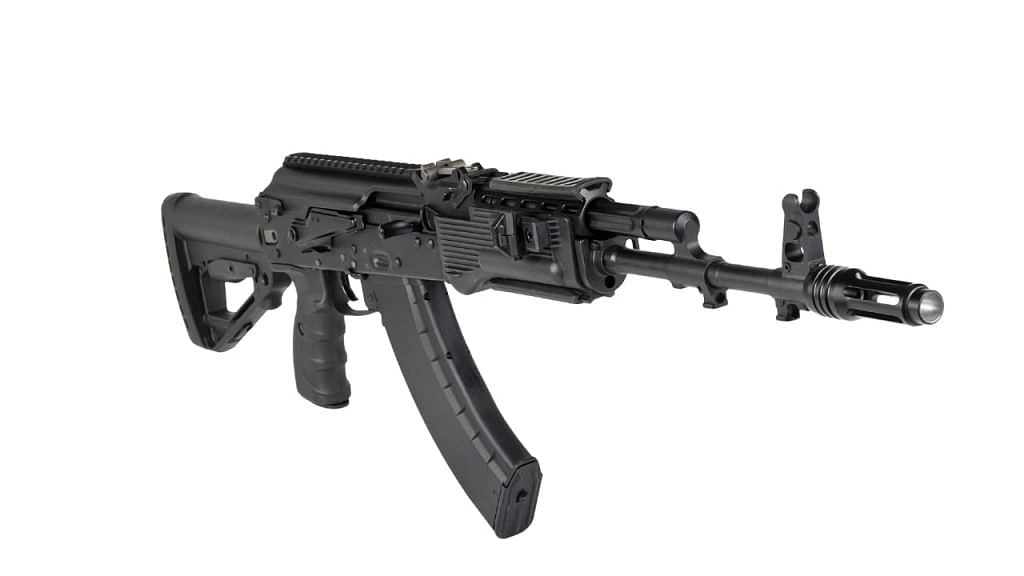Moscow: India and Russia are aiming to kickstart the joint production of AK-203 assault rifles, which will become the mainstay of the Indian military in the coming years, at the Korwa Ordnance Factory in Amethi this year.
Major General Sanjeev Sengar, the newly-appointed CEO of the factory, and his team are in Russia, working out the technical parameters of the new rifles, which would be manufactured under Make in India and could also possibly be exported.
“We have received an RFP (request for proposal) for more than 6,00,000 pieces of AK. We are hoping that, by end of July, the joint venture will reply to the RFP,” Vladimir Drozhzhov, the deputy director of the Russian government’s Federal Service for Military Technical Cooperation (FSMTC), told a group of journalists in Moscow.
“After that, we hope the contract will be signed soon between the JV and the Ministry of Defence in India,” he added.
AK-203 is one of the most modern assault rifles from the stable of Kalashnikov Concern, which churns out the famous AK-series rifles, including AK-47. It will be manufactured in India as part of a joint venture, Indo-Russia Rifles Private Limited, established between the Ordnance Factory Board (OFB), Kalashnikov Concern, and Rosoboronexport, the Russian state agency for military exports.
While OFB has a 50.5 per cent stake in the joint venture, Kalashnikov has 42 per cent and Rosoboronexport, 7.5 per cent.
“There is an agreement for complete Transfer of Technology and the provision for export is also included,” said Vladimir Onokoy, technical adviser to Kalashnikov.
The Amethi factory is ready to start operations, and it is expected that the production of the rifles will begin this year if all goes well. “We are aiming for the production to start soon. Teams from India and Russia are travelling and meeting with each other to iron out the process,” Onokoy added.
The decision to appoint a serving Major General as the Amethi factory’s CEO is a first in decades for the Army.
The Army has been concerned over low quality and delivery problems when it comes to ordnance factories’ products, so if this new model for the AK-203 factory is successful, it might just pave the way for a new set-up to oversee such facilities.
Also read: India prevails, US likely to exempt it from sanctions on arms import from Russia
What is AK-203?
Each AK-203 costs about $1,000. The rifle is chambered to fire 7.62×39 mm ammunition (same as the AK-47), and is expected to meet the Indian Army’s requirement for 6.5 lakh assault rifles.
This is in addition to the rifles ordered from US manufacturer SIG Sauer in January.
The new rifles will replace the 5.56×45 mm INSAS (Indian Small Arms System) rifles, which have been in use for over two decades.
Compared to the AK-103, which was originally meant for joint production, the AK-203 comes with collapsible stock and can be adjusted according to the height of the shooter. The rifle also has a more ergonomical pistol grip with finger burst.
There is a different safety mechanism for the rifle, because of which the soldier does not have to lose contact with the grip when changing firing modes during an operation.
There is also a new flash hider that comes handy when the assault rifle is used with night vision, as flash from the firing of a bullet can hamper visibility.
The rifle comes with a new barrel and also an interchangeable magazine with the standard 30 and 50 rounds.
“The best part is that the older magazine of the AK-series can also be used for this rifle,” Onokoy said.
This reporter is visiting Russia as a guest of United Shipbuilding Corporation.
Also read: India buying S-400 missile systems from Russia will have serious implications on defence ties: US
